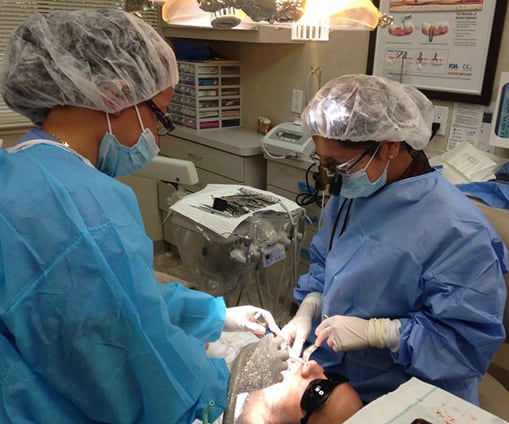Your gums, like your teeth, require excellent care. If tartar accumulates, bacteria can develop and cause an infection in your sensitive oral tissues. Gum disease is a serious concern that can have wide-ranging effects on the health of your mouth and body. Dr. Donian Shen, our skilled dentist in Mountain View, offers an extensive selection of periodontal (gum) treatments at our state-of-the-art office. These techniques are designed to reduce the effects of gum disease and protect your smile from further damage.
What Is Gum Disease?
Gum disease, or periodontal disease, is a common inflammatory condition affecting the tissues surrounding the teeth. It is primarily caused by bacterial infection. It typically starts as gingivitis, characterized by red, swollen gums that may bleed easily. If untreated, it can advance to periodontitis, where the infection damages the supporting bone and fibers that hold the teeth in place. Common symptoms include persistent bad breath, receding gums, loose teeth, and gum recession. Regular dental check-ups and proper at-home oral care are essential for prevention and management.
What Causes Gum Disease?
Gum disease is primarily caused by the buildup of dental plaque, a sticky film of bacteria that forms on teeth. If not regularly removed through brushing and flossing, plaque can harden into tartar, further irritating the gum line and leading to inflammation known as gingivitis. Without treatment, gingivitis can progress to periodontitis, where the inflammation and infection spread deeper, damaging the tissues and bones that support teeth. Additional risk factors include smoking, diabetes, hormonal changes (such as those during pregnancy), certain medications that reduce saliva flow, genetic susceptibility, and conditions that compromise the immune system.

Are There Different Stages of Gum Disease?
Periodontal disease is a developing condition that is commonly categorized in three different stages:
- Stage One – Gingivitis
Gingivitis is the initial stage of gum disease. At this point, the build-up of bacteria begins to irritate the gums, which can be seen as red, inflamed gum tissue that may bleed during brushing and flossing. However, it is also possible for gingivitis not to display any visible symptoms. It is very important to maintain daily oral hygiene care and attend routine dental cleanings and exams to prevent gingivitis from worsening. - Stage Two – Periodontitis
The next stage of gum disease, periodontitis, begins to develop below the gumline, in which untreated bacteria may cause deep pockets to form between the teeth and gums. Periodontitis allows plaque and food to become trapped and permeate the soft tissue and bone within these pockets. At this point, treatments may be performed to remove the plaque and bacteria; however, damage and recession to the gums may be permanent. - Stage Three – Advanced Periodontitis
Once gum disease progresses to advanced periodontitis, individuals will generally experience more severe symptoms, including permanent gum recession, loose and/or shifting teeth, connective fiber damage, and more. If untreated, advanced periodontitis may lead to significant oral discomfort, bite irregularities, tooth extractions or tooth loss, other oral health problems, and even increased risks to general health.
Dr. Shen and the team at Smile By Design strongly encourage preventative dental care to avoid long-term, painful damage to your teeth and gums caused by periodontal disease.
“I went to Smile by Design for two different treatments in the last two months. They welcomed me with the greatest warmth and made me feel that I was in good hands. The entire team is amazing! I highly recommend it.”
What Are the Health Risks of Gum Disease?
In addition to the oral health concerns that can arise from gum disease, clinical studies have shown that periodontal disease may also be linked to various other health problems.1 The research conveys there may be a systemic connection between untreated infections that start in the mouth spreading to other areas of the body. This may lead to greater health risks, such as heart disease, strokes, osteoporosis, respiratory disease, and certain cancers. Dr. Shen advises patients to schedule regular dental exams and x-rays as recommended, along with daily brushing and flossing, to identify oral and periodontal health conditions as early as possible.
How Much Does Gum Disease Treatment Cost?
At Smile By Design, periodontal treatment may range between $280 and $1,980, depending on the severity of the condition, stage of gum disease, and other recommended services. After meeting with Dr. Shen, our team will provide a detailed treatment plan and estimate of costs based on your individual needs. Please keep in mind that gum disease treatment is often at least partially covered by dental insurance policies, so it is best to review your benefits to see what services may be covered. Additionally, our practice offers access to third-party financing options for qualified applicants, which can provide installment plans for the price of treatment.
If your periodontal concerns are more cosmetic than functional in nature, we also offer gummy smile treatment, which can improve the appearance of your smile. For more information about our gum disease techniques, or if you would like to schedule a complimentary consultation with Dr. Shen, please contact us today.


